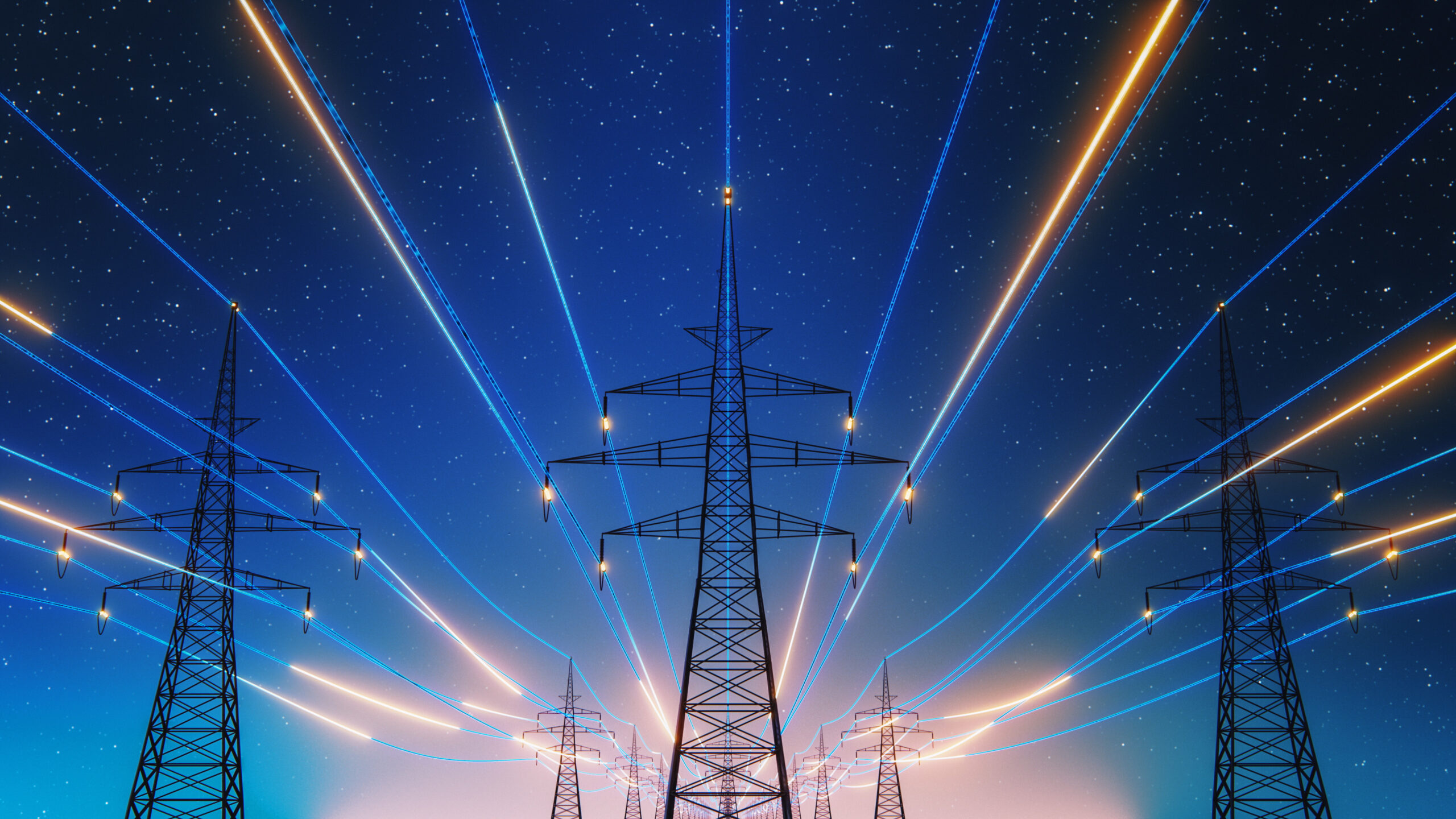
50 years that have changed Britain’s energy



Electricity trading is the process of power generators selling the electricity they generate to power suppliers, who can then sell this electricity on to consumers. The system operator – National Grid ESO in Great Britain – oversees the flow of electricity around the country, and ensures the amounts traded will ultimately meet demand and do not overwhelm the power system.
There are three main parties in a power market: generators (thermal power plants and energy storage sites, sources such as wind turbines and solar panels producing electricity), consumers (hospitals, transport, homes and factories using electricity), and suppliers in the middle from whom you purchase electricity.
Electricity is generated at power stations, then bought by suppliers, who then sell it on to meet the needs of the consumers.
Electricity trading refers to the transaction between power generators, who produce electricity, and power suppliers, who sell it on to consumers.
Electricity trading occurs in both long- and short-term time frames, ranging from years in advance to deals covering the same day. Generation and supply must meet exact demand for every minute of the day, which means that traders must always be ready to buy or sell power to fill any sudden gaps that arise.
When trading electricity far in advance, factors such as exchange rates, the cost and availability of fuel, changing regulations and policies all affect the price. Short-term price is more volatile, and factors such as weather, news events and even what’s on television having the biggest impact on price.
Traders analyse live generation data and news reports, to predict ahead of time how much electricity will be needed during periods of high demand and then determine a price. Traders then make offers and bids to suppliers and strike a deal – these deals then dictate how and when a power station’s generators are run every day.

Running a power station is an expensive process and demand for electricity never stops. The electricity market ensures the country’s power demands are met, while also aiming to keep electricity businesses sustainable, through balancing the price of buying raw materials with the price at which electricity is sold.
To ensure the grid remains balanced and meets demand, the systems operator also makes deals with generators for ancillary services, either far in advance, or last-minute. This ensures elements such as frequency, voltage and reserve power are kept stable across the country and that the grid remains safe and efficient.
Electricity trading ensures there is always a supply of power and that the market for electricity operates in a stable way
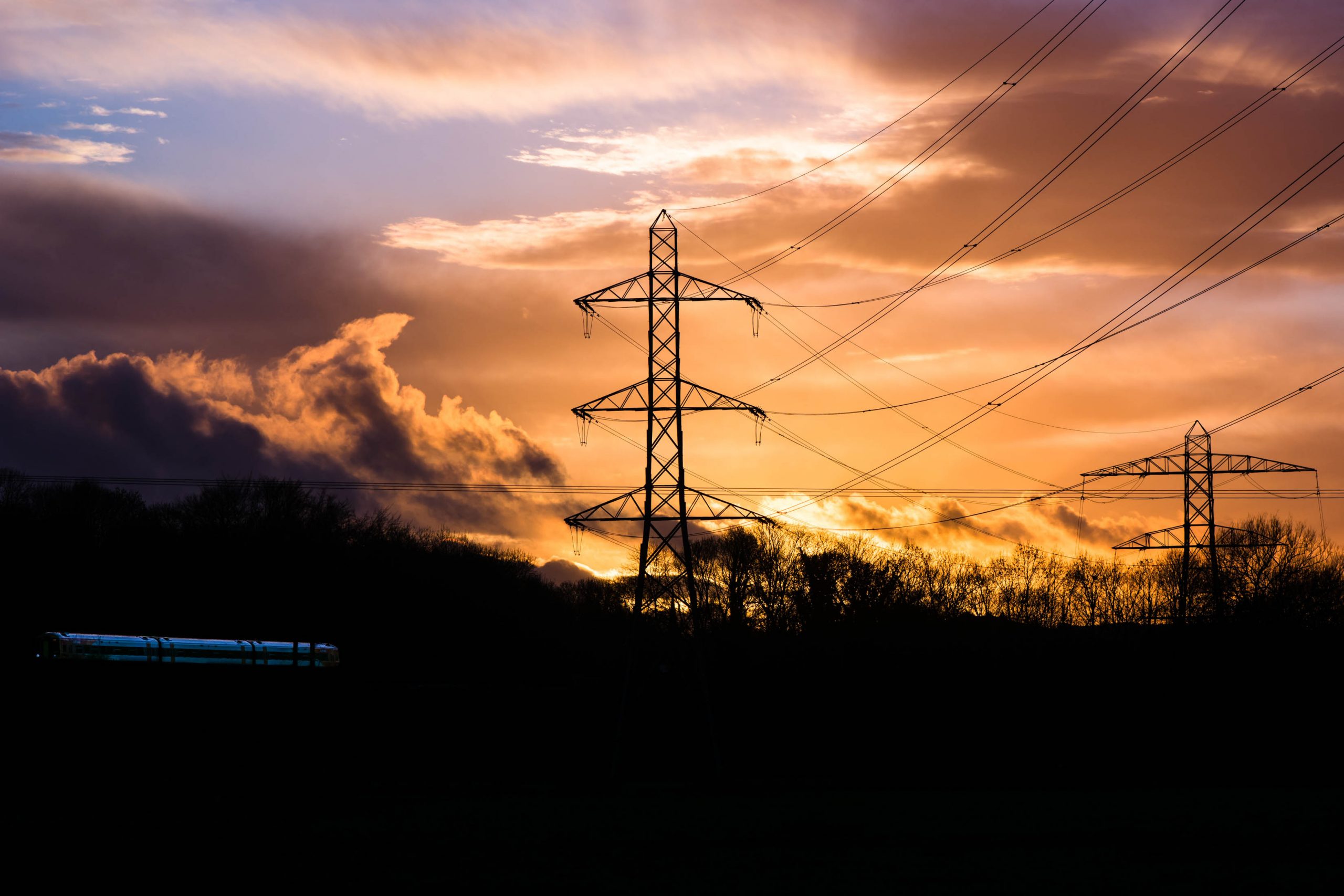
The actions that National Grid takes to manage the power system have typically amounted to 5% of generation costs over the last decade, but this share has quadrupled over the last two years. In the first half of 2020, the cost of these actions averaged £100 million per month.
Supplying electricity to our homes and workplaces needs more than just power stations generating electricity.
Supply and demand must be kept perfectly in balance, and flows of electricity around the country must be actively managed to keep all the interconnected components stable and prevent blackouts. National Grid’s costs for taking these actions have been on the rise, as we reported over the previous two summers; but recently they have skyrocketed.
At the start of the decade, balancing added about £1/MWh to the cost of electricity, but last quarter it surpassed £5/MWh for the first time (see below).
Balancing prices have risen in step with the share of variable renewables. The dashed line below shows that for every extra percent of electricity supplied by wind and solar adds 10 pence per MWh to the balancing price. Last quarter really bucks this trend though, and balancing prices have risen 35% above the level expected from this trend. The UK Energy Research Centre predicted that wind and solar would add up to £5/MWh to the cost of electricity due to their intermittency, and Britain has now reached this point, albeit a few years earlier than expected.
This is partly because keeping the power system stable is requiring more interventions than ever before. With low demand and high renewable generation, National Grid is having to order more wind farms to reduce their output, at a cost of around £20 million per month. They even had to take out a £50+ million contract to reduce the output from the Sizewell B nuclear reactor at times of system stress.
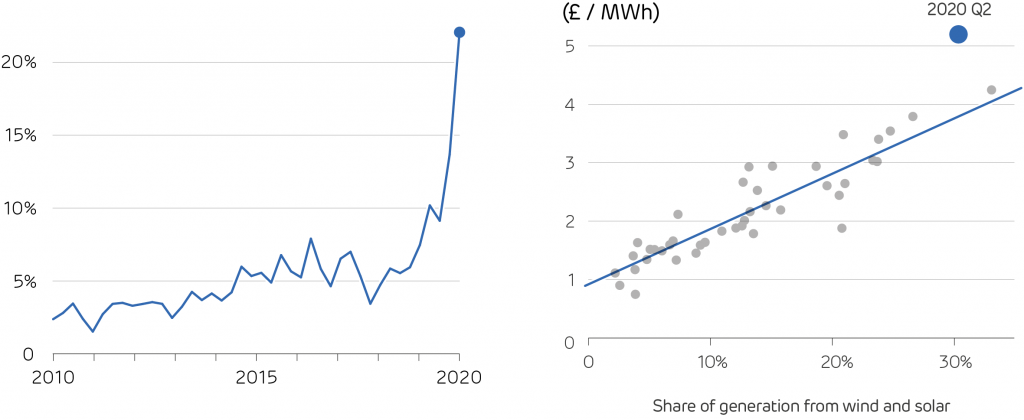
[Left] The quarterly-average cost of balancing the power system, expressed as a percentage of the cost of generation. [Right] Balancing price shown against share of variable renewables, with dots showing the average over each quarter
For a quarter of a century, the electricity demand in GB ranged from 19 to 58 GW*. Historically, demand minus the intermittent output of wind and solar farms never fell below 14 GW. However, in each month from April to June this year, this ‘net demand’ fell below 7 GW.
Just as a McLaren sports car is happier going at 70 than 20 mph, the national grid is now being forced to operate well outside its comfort zone.
This highlights the importance of the work that National Grid must do towards their ambition to be ready for a zero-carbon system by 2025. The fact we are hitting these limits now, rather than in a few years’ time is a direct result of COVID. Running the system right at its limits is having a short-term financial impact, and is teaching us lessons for the long-term about how to run a leaner and highly-renewable power system.
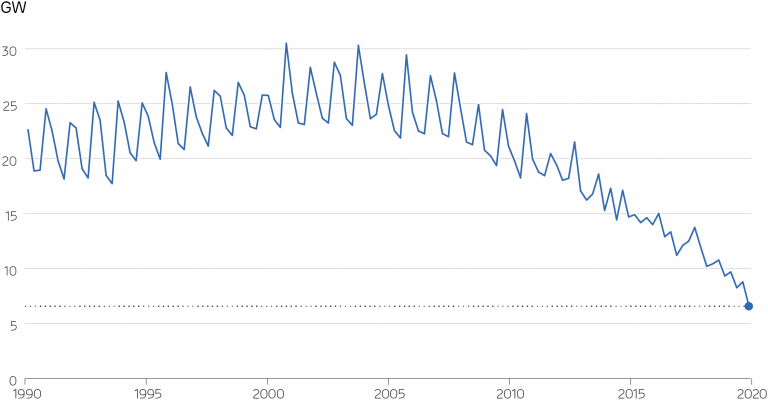
Minimum net demand (demand minus wind and solar output) in each quarter since 1990
Read full Report (PDF) | Read full Report | Read press release
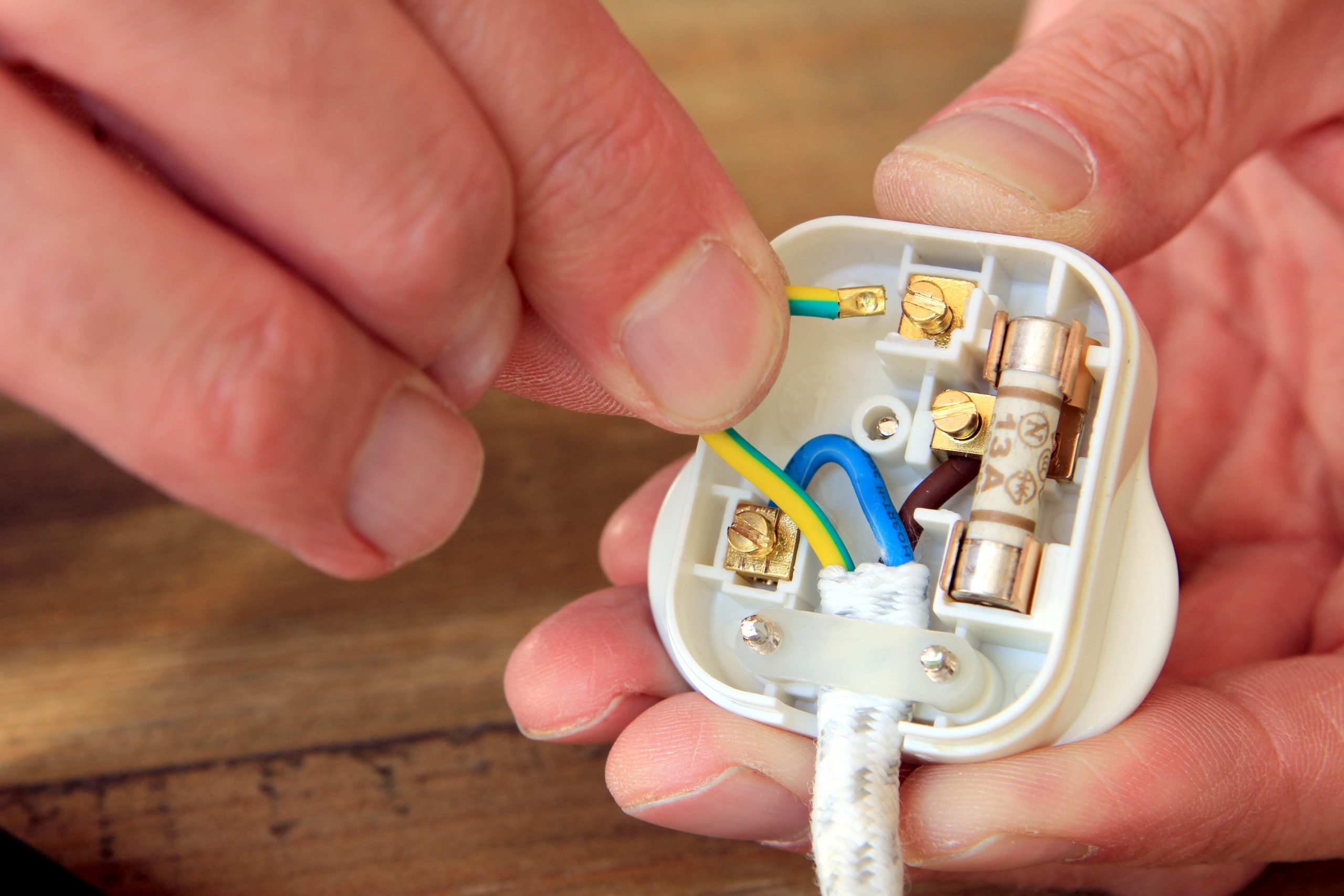
It may be bulkier than its foreign cousins and its flat back might make it the perfect household booby trap, but the UK plug is a modern-day design marvel.
The UK’s ‘G Type’ (or BS 1363) plug is a product of the post-war age. But it has endured for the better part of a century, ensuring homes, business and sockets around the UK have access to safe, usable electricity. Even as the devices they power have changed, become smarter and more connected, the three-prong G Type remains unchanged.
But to understand how it came into being, it’s worth first understanding what makes it such a unique and clever bit of design – including its role in achieving the ambitions of one of Great Britain’s pioneering female engineers, and its money-saving abilities.
The modern plug used across Great Britain (as well as Ireland, Cyprus, Hong Kong and Malaysia) is a smarter and more advanced item than many of its contemporaries. This is thanks to a number of key, but often overlooked, features.
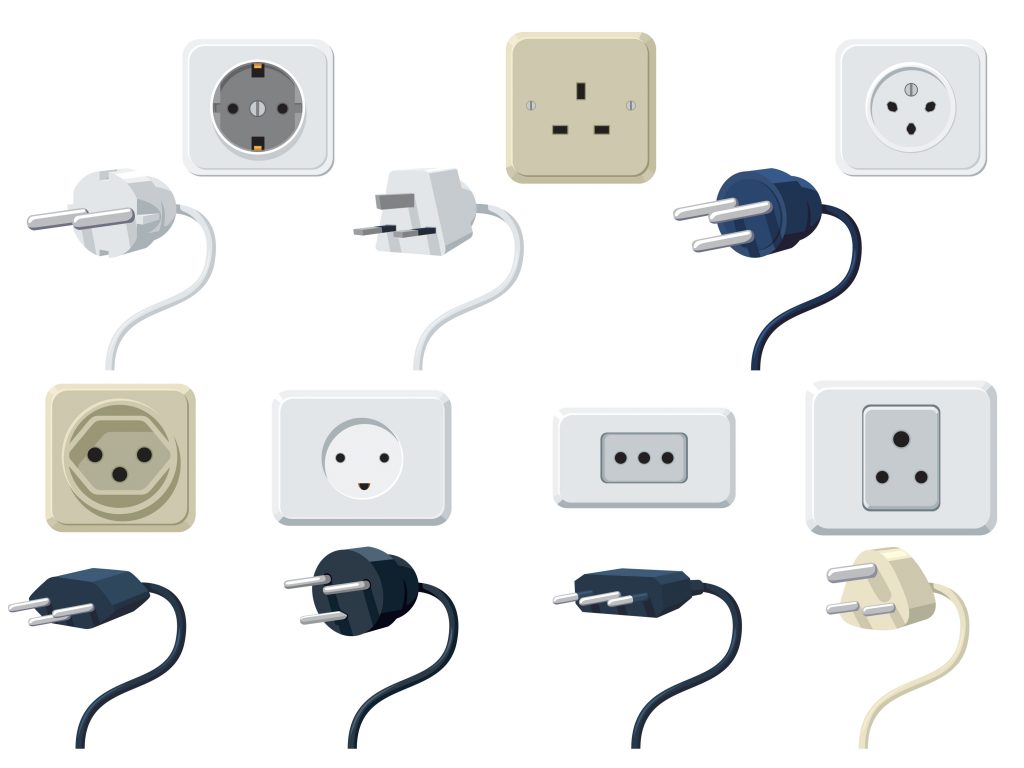
A collection of international power point illustrations
The first is its earth prong. Connecting the plug to the earth means if a wire comes loose in, say, a toaster and touches a metal part, the device will short circuit as the electricity runs through to make contact with the earth, rather than the entire item becoming electrified and dangerous.
The longer earth prong also plays the role of ‘gatekeeper’ for the entire plug. When a plug enters a socket the longer earth prong enters before any others, pushing back plastic shutters that sit over the live and neutral entrances. This means when there is no plug in a socket the live and neutral ports, which actually carry electric current to devices, are covered over making it very difficult for a child to push anything dangerous into the socket.
Another clever feature inside the Great British plug comes in the form of a fuse connected to the live wire. If there’s an unexpected electrical surge the fuse will blow and cut off the connected device, preventing fires and electrocutions.All packaged together, the G Type plug is far from the most compact version – yet it is hugely effective. However, these ideas didn’t come together at the flick of a switch.
Going back to end of the 19th Century, the idea of owning devices you could move around your house and connect to the electricity circuit from different rooms was novel.
Electricity’s main role in homes was for lighting and was fixed into walls and ceilings, with their cables hidden. It wasn’t until the rise of new electrical appliances in the 20th century that the need for an easy way to plug electrical items into circuits arose.
A series of two-pronged plugs first emerged in 1883, but there was no standardisation of design which would allow any appliance to be plugged into any socket. That began to change in 1904, when US inventor Harvey Hubbell developed a plug that allowed non-bulb electrical devices to be connected into an existing light socket, eliminating the need for the installation of new sockets.
By 1911, a design for a three-pronged plug with an earth connection had emerged, with manufacturer AP Lundberg bringing the first of this kind of plug to Britain.
By 1934, regulations appeared requiring plugs and sockets to include an earthing prong, which eventually gave birth to a three, cylindrical-pronged plug: the BS 546.
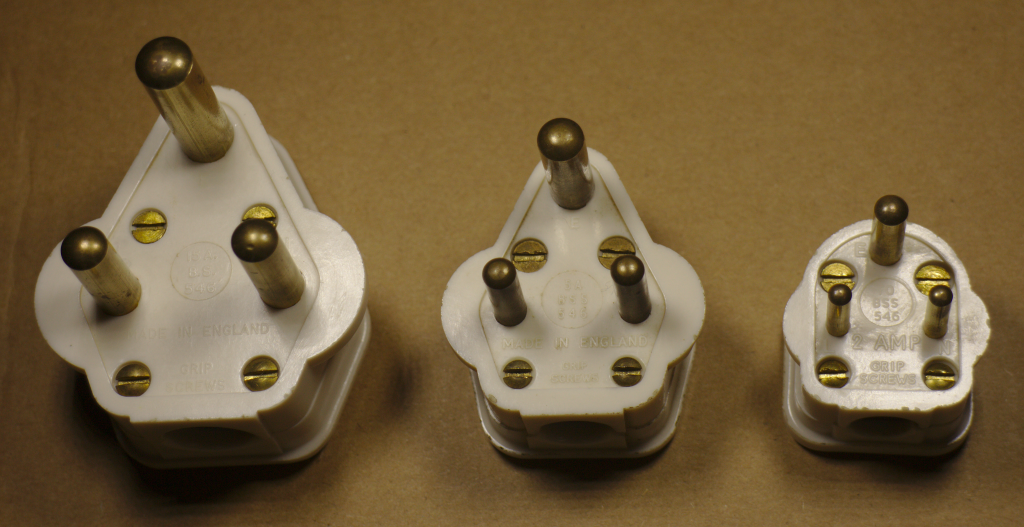
BS 546 plugs
The BS 546 was different from the modern G-Type as they didn’t contain a fuse and were available in five different sizes depending on the needs of the appliance, from small 2 ampere plugs for low-power appliances to a larger 30 ampere version for industrial machinery. The different sizes and spacing of the prongs prevented low-power devices accidentally being plugged into high-power outlets.
Any chance of globally standardising plugs was doomed from the beginning, as different companies in different countries all began developing their own plugs for their products as electricity rapidly gained uptake.
Some attempts were made by the International Electrotechnical Commission (IEC) to standardise plugs globally but the Second World War put a stop to any progress.
Great Britain emerged from the Second World War with its national grid standing strong. The challenge now was to make electricity not just the power source of factories and wealthy people’s homes, but something available for everyone in the wave of new post-war construction.
Other countries, not seeing as much damage to their housing stock as the UK, did not have the same opportunity to rethink domestic electricity to such an extent. Therefore, the Institution of Electrical Engineers (IEE) assembled a 20-person committee to consider the electrical requirements of the country’s new homes.
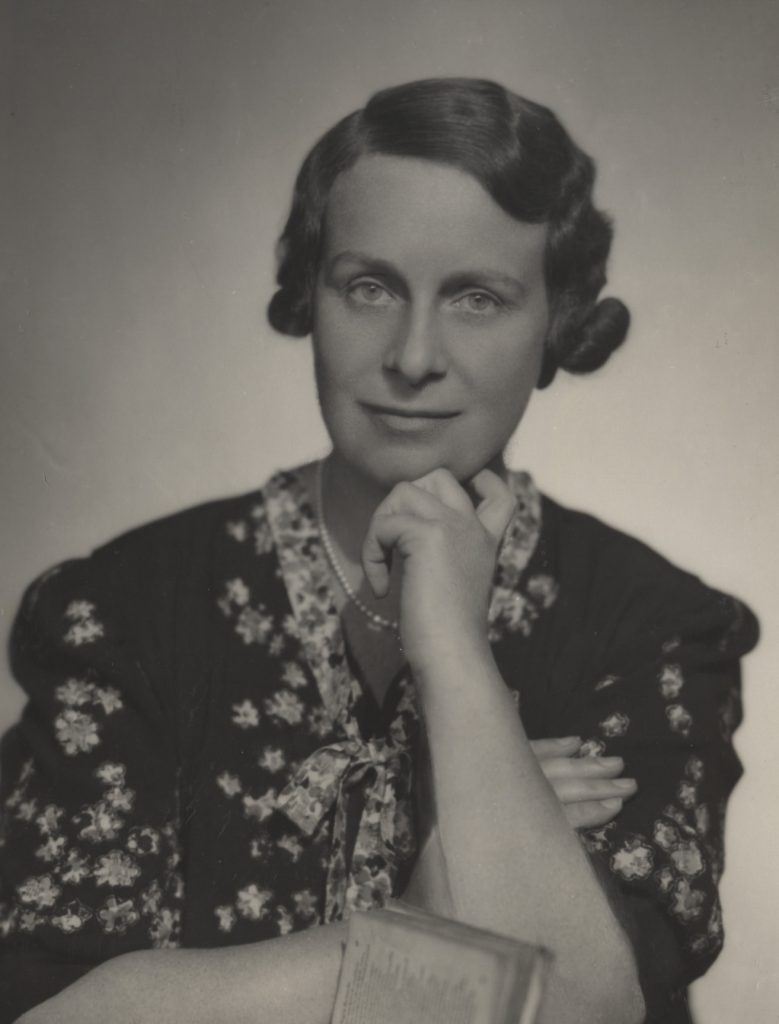
Breaking new ground: Caroline Haslett
The sole woman on the committee, Caroline Haslett, had been breaking new ground for female engineers since before World War One. In her career she worked with turbine inventor Charles Parsons and his wife (an engineer in her own right) and in 1932 became the first woman selected to join the IEE. Her passion for electricity went so far as for her will to request she be cremated via electricity.
She had long believed in the potential for domestic electricity to improve women’s lives by freeing them from the drudgery of pre-electric domestic chores, from handwashing clothes to cooking on coal-fuelled stoves. This included ensuring electricity was safe for the people using electricity around the home which in the 1940s was primarily women, who also did the vast majority of childcare.
Haslett’s drive to make electricity safe in the home was pivotal in shaping many of the IEE’s safety requirements for post-war domestic electricity, including what have become the country’s standard plugs and sockets.
There was another factor aside from safety at play. The material cost of the war meant copper, the main material used in electrical wiring, was in short supply, so the IEE came up with a new way of wiring homes that would in turn shape our plugs.
Before the war, British sockets were all separately wired back to a central fuse box. It made sense, because if something went wrong only the fuse connected to that socket would blow rather than the whole house.
However, to cut the amount of copper used the IEE instead proposed a clever workaround where the home’s electrical sockets are looped up in one Ring Circuit, with the fuses moved to the plugs themselves. So, if something went wrong in an appliance the fault would stop at the plug, where the fuse could easily be accessed and replaced. Lighting fixtures remained wired in a separate circuit from sockets as they require less current to operate.
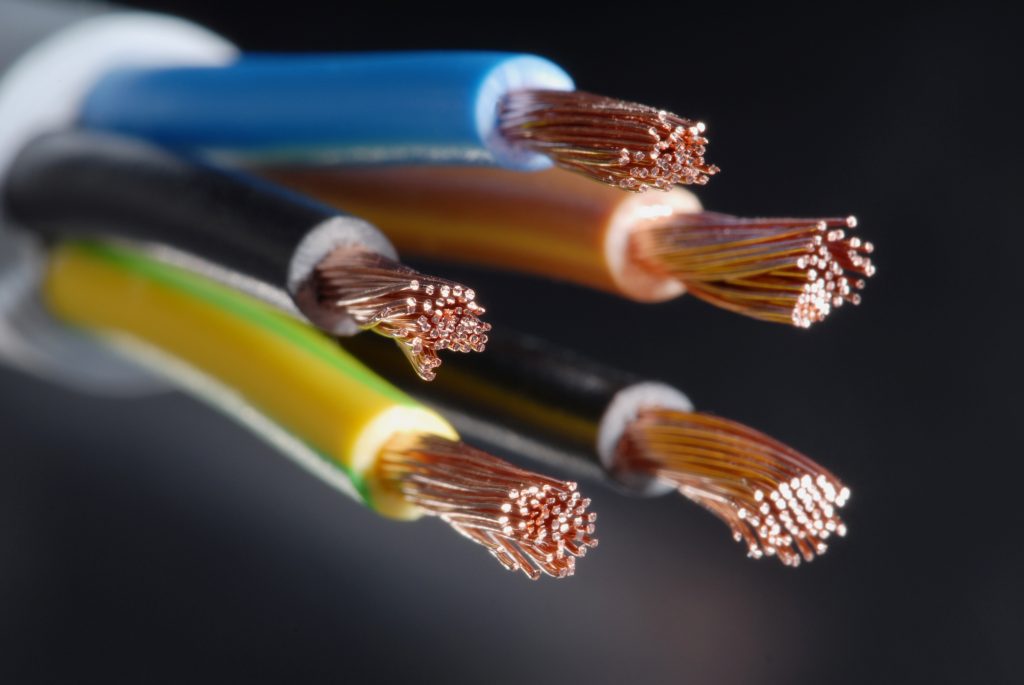
Copper was short in supply during World War Two.
This hidden fuse, is a big differentiator from other plug types and adds to the G Type’s safety credentials. However, the IEE had to ensure people did not mistakenly insert older three-prong BS 546 plug styles without fuses into the sockets.
The answer was as simple as switching the socket holes from round to rectangle. It means the older round cylinder prongs wouldn’t fit into the slot designed for the rectangles found on plugs today.
The G Type plug might seem cumbersome compared to the European or US models, but in the 70-plus years since its introduction its three prongs and in-built fuse, has proved an enduring design that can power new devices and smart technology, while remaining one of the safest plugs in the world.

How long do your electrical devices last? We’re not talking about battery life, but the overall lifetime of the items we use every day that are powered by electricity.
It’s accepted that today’s electrical devices have short life spans, in part a symptom of rapidly evolving technology fuelling the need for constant consumer updates and in part a result of planned obsolescence (devices being manufactured to fail within a set number of years to encourage repeat purchases). Electrical devices aren’t purchased with the belief they will last a lifetime.
But it hasn’t always been this way. Before rapid technological development and the rise of fast consumerism, devices were built to last.
Over the relatively short history of electrical appliances, there are tools and equipment that have operated for decades. Some of these remain in operation today with hardly any alterations, but for a few tweaks here and there to upgrade or preserve.
Built to last, here are a few of the longest running electrical inventions.
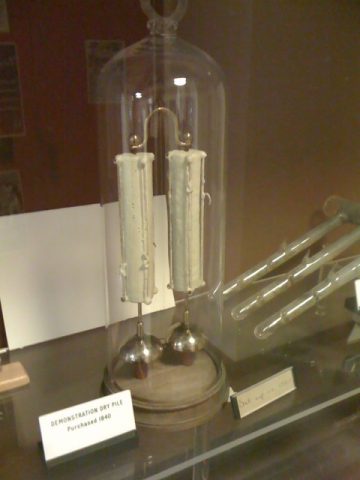
The Oxford Electric Bell located in the Clarendon Laboratory, University of Oxford.
The Oxford Electric Bell is not your typical bell – not just in how it looks, but in the fact it has been in constant operation since the mid 19th Century. It consists of two primitive batteries called ‘dry piles’ with bells fitted at each end and a metal ball that vibrates between them to very quietly, continuously ring.
Its original purpose is unidentified, but what is known is that the bell is the result of an experiment put on by the London instrument-manufacturing firm Watkins and Hill in 1840. Acquired by Robert Walker, a physics professor at the University of Oxford in the mid 1800s, it’s displayed at Oxford’s Clarendon Laboratory which explains why it’s also known as the Clarendon Pile.
The exact make-up of the dry piles is unknown, as no one wants to tamper with them to investigate their composition out for fear of ending the bell’s 179-year-long streak. As a result, confusion remains as to why The Oxford Electric Bell has remained in operation for so long.

Souter Lighthouse, Tyneside, England.
The lamp in the Souter lighthouse, situated between the rivers Tyne and Wear, was the most advanced of its day when it was first constructed. Designed to use an alternating electric current, it was the first purpose-built, electrically powered lighthouse in the world. Although no longer in operation today, it ran unchanged for nearly 50 years.
The light was generated using carbon arc lamps, and it originally produced a beam of red light that would come on once every five seconds.
Souter’s original lamp operated unchanged from 1871 to 1914, when it was replaced by more conventional oil lamps. It was altered again to run on mains electric power in 1952 and was finally deactivated in 1988.
Tourism hit the Isle of Man in the 1880s and with it came the construction of hotels and boarding houses. Two businessmen saw this as an opportunity to purchase a large estate on the island and develop it into housing and a pleasure development. The Manx Parliament approved the sale in 1892 on one condition: that a road and a tramway be built to give people access.

Snaefell mountain railway station, Isle of Man.
It was decided that the tram would be electric, and work began in the spring of 1893, with the tram system up and running by September of that year. Although the track and its cars have been extended and updated over time, the first three cars remain the longest running electric tramcars in the world.
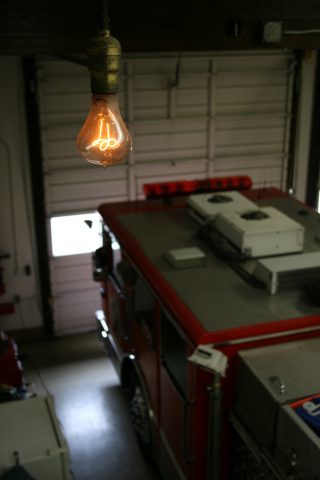
Photograph by Dick Jones (centennialbulb.org)
The unassuming Centennial Bulb has been working in the Livermore, California Fire Department for 117 years. The bulb was first installed in 1902 in the department’s hose cart house, but was later moved to Livermore’s Fire Station 6, where it has been illuminated for more than a million hours.
Throughout its life the Centennial Bulb has seen just two interruptions: for a week in 1937 when the Firehouse was refurbished, and in May 2013 when it was off for nine and a half hours due to a failed power supply. Made by the Shelby Electric Company, the hand-blown bulb previously shone at 60 watts but has since been dimmed to 4 watts.
While this means it isn’t able to actually illuminate much, it is a reminder that despite the disposable nature of many modern electrical devices, it’s possible to build electrical items that last.
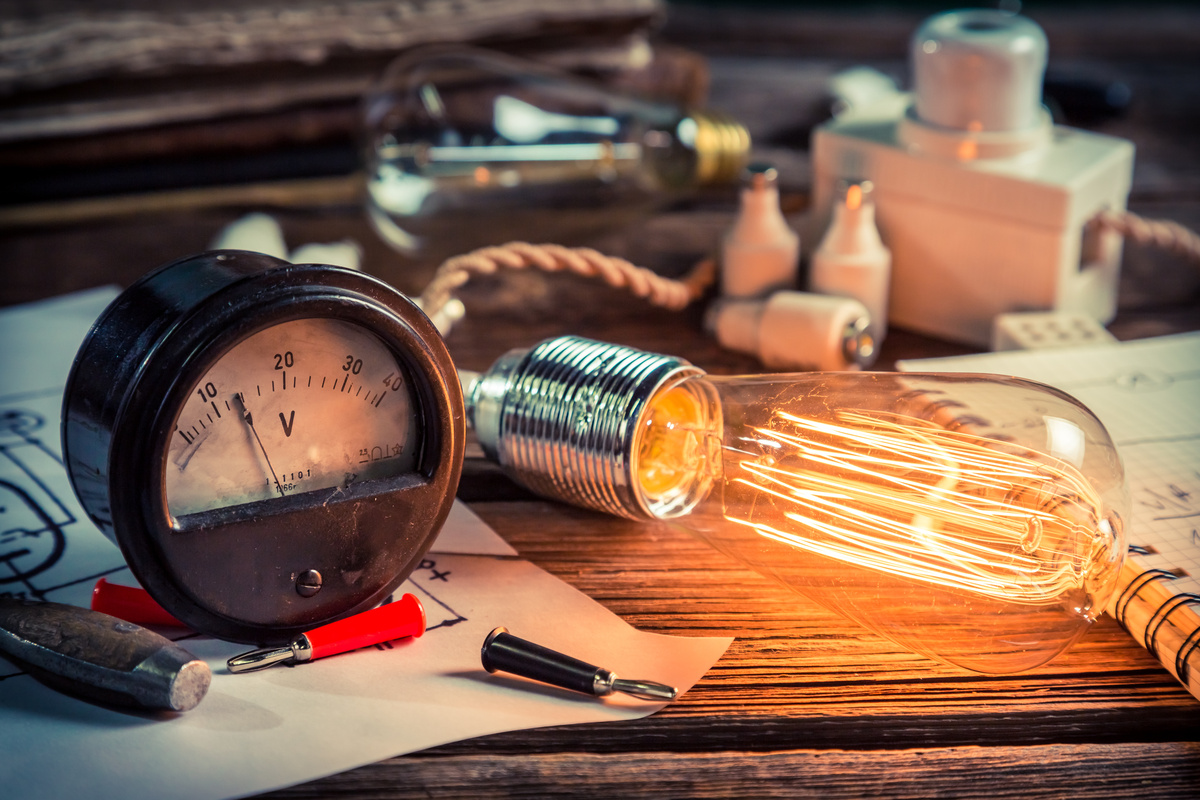
Electricity is such a universal and accepted part of our lives it’s become something we take for granted. Rarely do we stop to consider the path it took to become ubiquitous, and yet through the course of its history there have been several eureka moments and breakthrough inventions that have shaped our modern lives. Here are some of the defining moments in the development of electricity and power.
Ancient Egyptians referred to electric catfish as the ‘thunderers of the Nile’, and were fascinated by these creatures. It led to a near millennia of wonder and intrigue, including conducting and documenting crude experiments, such as touching the fish with an iron rod to cause electric shocks.
Around 500 BC Thales of Miletus discovered that static electricity could be made by rubbing lightweight objects such as fur or feathers on amber. This static effect remained unknown for almost 2,000 years until around 1600 AD, when William Gilbert discovered static electricity in earnest.
The Latin word ‘electricus’, which translates to ‘of amber’ was used by the English physician, William Gilbert to describe the force exerted when items are rubbed together. A few years later, English scientist Thomas Browne translated this into ‘electricity’ in his written investigations in the field.
This book of Benjamin Franklin’s discoveries made about the behaviour of electricity was published in 1751. The publication and translation of American founding father, scientist and inventor’s letters would provide the basis for all further electricity experimentation. It also introduced a host of new terms to the field including positive, negative, charge, battery and electric shock.
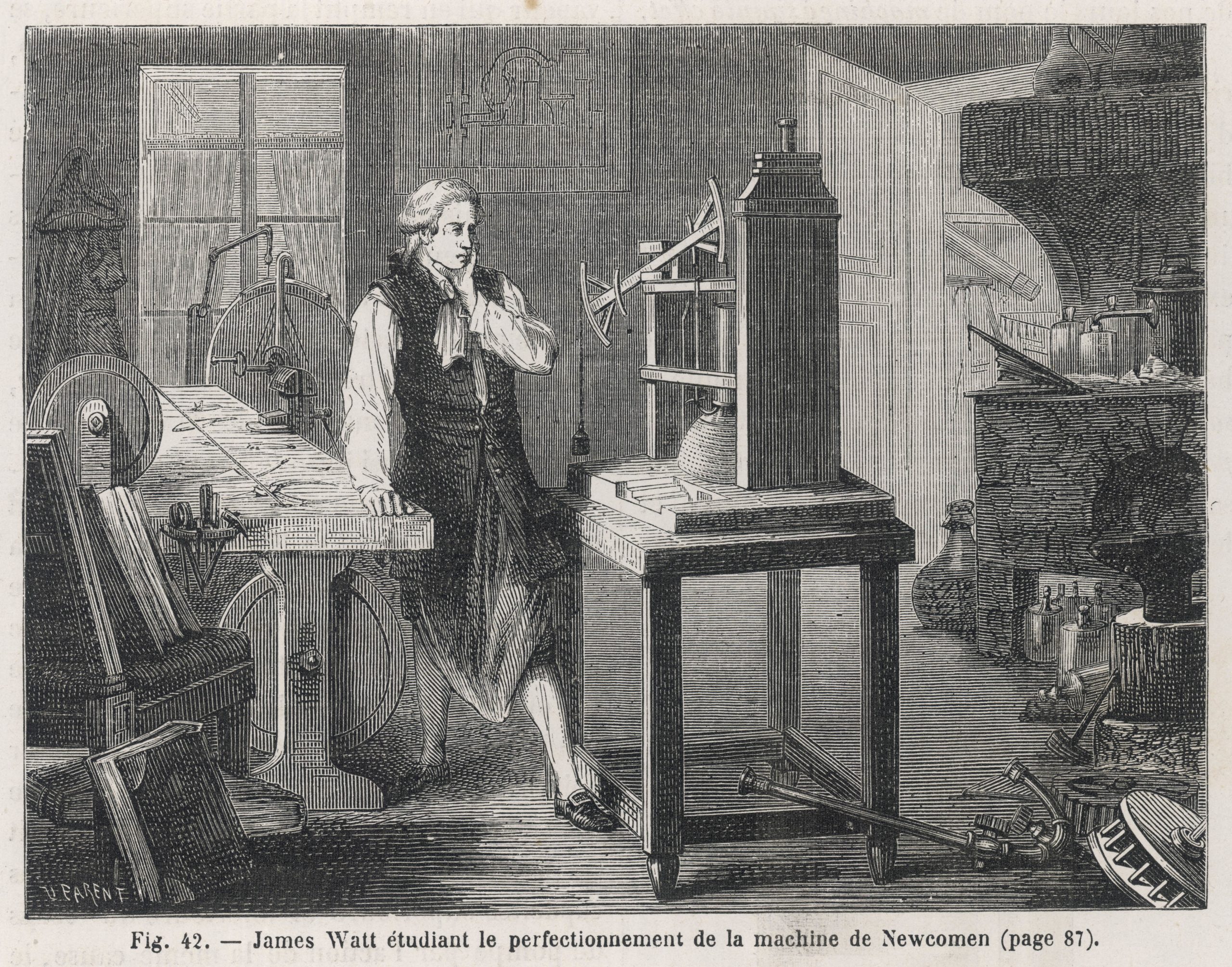
Watt studies Newcomen’s engine
James Watt transformed the Industrial Revolution with the invention of a modified Newcome engine, now known as the Watt steam engine. Machines no longer had to rely on the sometimes-temperamental wind, water or manpower – instead steam from boiling water could drive the pistons back and forth. Although Watt’s engine didn’t generate electricity, it created a foundation that would eventually lead to the steam turbine – still the basis of much of the globe’s electricity generation today.
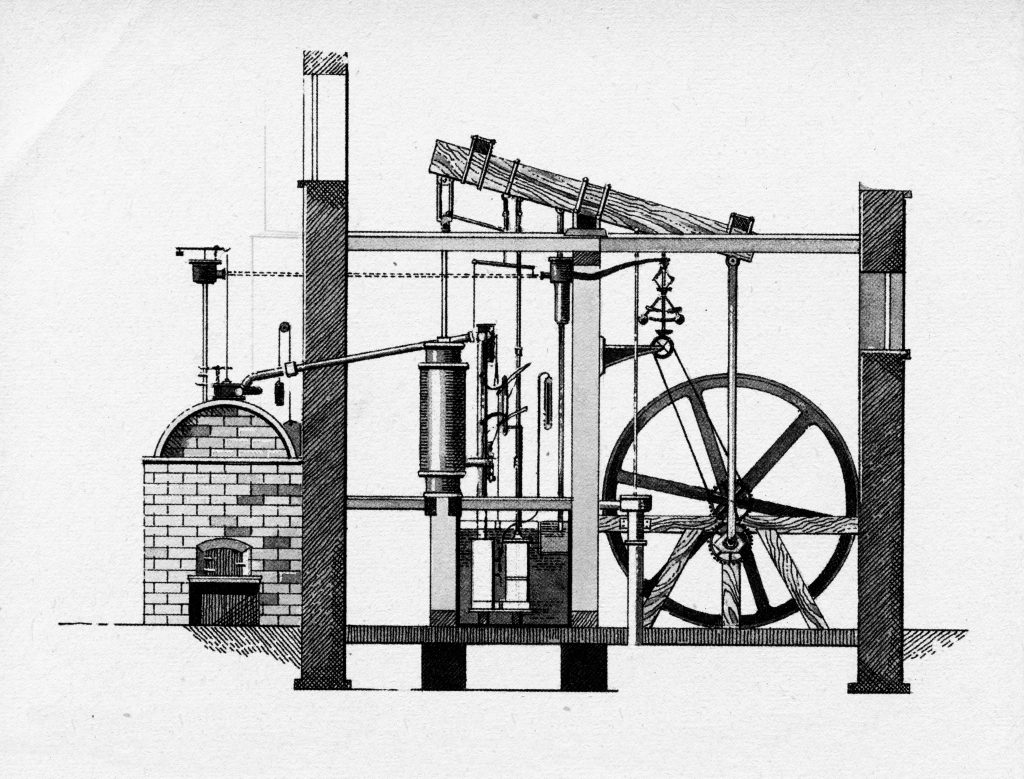
James Watt’s steam engine
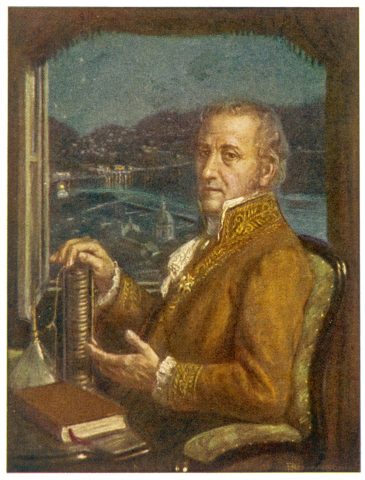
Alessandro Volta
Documented records of battery-like objects date back to 250 BC, but the first true battery was invented by Italian scientist Alessandro Volta in 1800. Volta realised that a current was created when zinc and silver were immersed in an electrolyte – the principal on which chemical batteries are still based today.
Breakthroughs in electric motors and batteries in the early 1800s led to experimentation with electrically powered vehicles. The British inventor Robert Anderson is often credited with developing the first crude electric carriage at the beginning of the 19th century, but it would not be until 1890 that American chemist William Morrison would invent the first practical electric car (though it closer resembled a motorised wagon), boasting a top speed of 14 miles per hour.
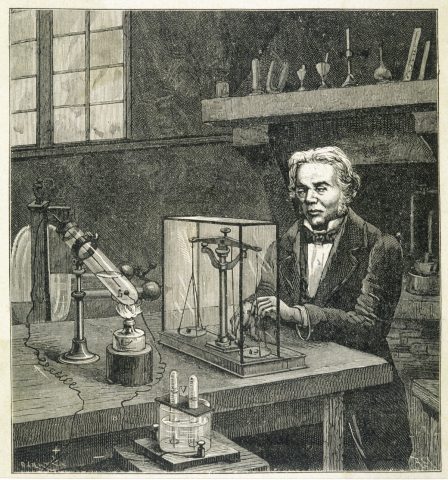
Michael Faraday
Faraday’s invention of the electric dynamo power generator set the precedent for electricity generation for centuries to come. His invention converted motive (or mechanical) power – such as steam, gas, water and wind turbines – into electromagnetic power at a low voltage. Although rudimentary, it was a breakthrough in generating consistent, continuous electricity, and opened the door for the likes of Thomas Edison and Joseph Swan, whose subsequent discoveries would make large-scale electricity generation feasible.
Thomas Edison patented the first practical and accessible incandescent light bulb, using a carbonised bamboo filament which could burn for more than 1,200 hours. Edison made the first public demonstration of his incandescent lightbulb on 31st December 1879 where he stated that, “electricity would be so cheap that only the rich would burn candles.” Although he was not the only inventor to experiment with incandescent light, his was the most enduring and practical. He would soon go on to develop not only the bulb, but an entire electrical lighting system.
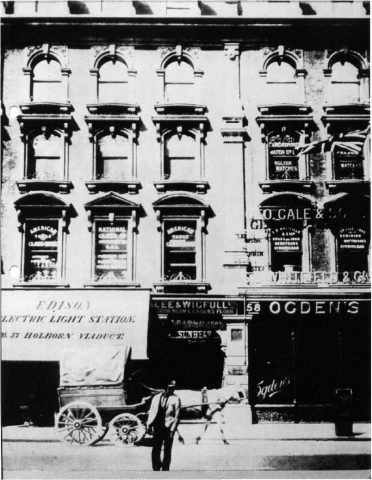
Holborn Viaduct power station via Wikimedia
Holborn Viaduct power station, also known as the Edison Electric Light Station, burnt coal to drive a steam turbine and generate electricity. The power was used for Holborn’s newly electrified streetlighting, an idea which would quickly spread around London.
Nikola Tesla and Thomas Edison waged what came to be known as the current war in 1880s America. Tesla was determined to prove that alternating current (AC) – as is generated at power stations – was safe for domestic use, going against the Edison Group’s opinion that a direct current (DC) – as delivered from a battery – was safer and more reliable.
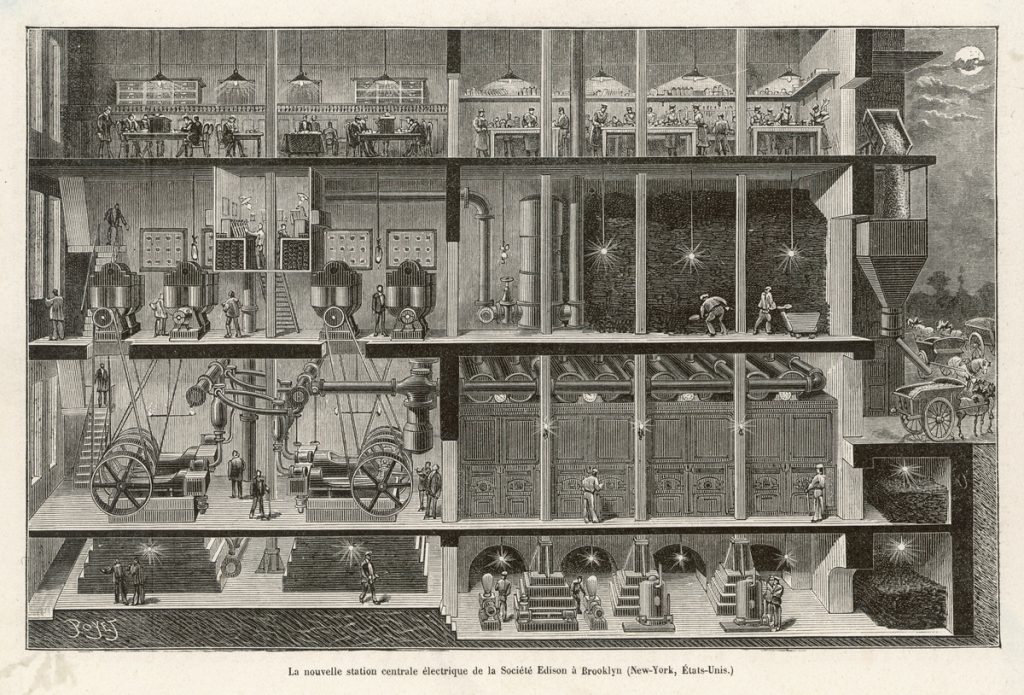
Inside an Edison power station in New York
The conflict led to years of risky demonstrations and experiments, including one where Tesla electrocuted himself in front of an audience to prove he would not be harmed. The war continued as they fought over the future of electric power generation until eventually AC won.
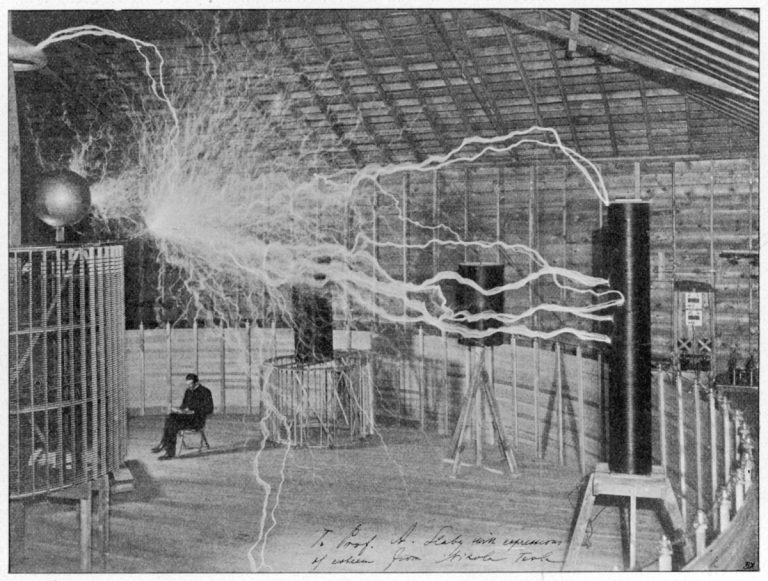
Nikola Tesla
Before Charles Mertz and William McLellan of Merz & McLellan built the Neptune Bank Power Station in Tyneside in 1901, individual factories were powered by private generators. By contrast, the Neptune Bank Power Station could supply reliable, cheap power to multiple factories that were connected through high-voltage transmission lines. This was the beginning of Britain’s national grid system.
Concepts for electric cars had been around for a century, however, the General Motors EV1 was the first model to be mass produced by a major car brand – made possible with the breakthrough invention of the rechargeable battery. However, this EV1 model could not be purchased, only directly leased on a monthly contract. Because of this, its expensive build, and relatively small customer following, the model only lasted six years before General Motors crushed the majority of their cars.
The International Renewable Energy Agency’s (IRENA) 2018 annual statistics revealed that renewable energy accounted for a third of global power capacity in 2018. Globally, total renewable electricity generation capacity reached 2,351 GW at the end of 2018, with hydropower accounting for almost half of that total, while wind and solar energy accounted for most of the remainder.
How do you get a drink in space? That was one of the challenges for NASA in the 1960s and 70s when its Gemini and Apollo programmes were first preparing to take humans into space.
The answer, it turned out, surprisingly lay in the electricity source of the capsules’ control modules. Primitive by today’s standard, these panels were powered by what are known as fuel cells, which combined hydrogen and oxygen to generate electricity. The by-product of this reaction is heat but also water – pure enough for astronauts to drink.
Fuel cells offered NASA a much better option than the clunky batteries and inefficient solar arrays of the 1960s, and today they still remain on the forefront of energy technology, presenting the opportunity to clean up roads, power buildings and even help to reduce and carbon dioxide (CO2) emissions from power stations.
At its most basic, a fuel cell is a device that uses a fuel source to generate electricity through a series of chemical reactions.
All fuel cells consist of three segments, two catalytic electrodes – a negatively charged anode on one side and a positively charged cathode on the other, and an electrolyte separating them. In a simple fuel cell, hydrogen, the most abundant element in the universe, is pumped to one electrode and oxygen to the other. Two different reactions then occur at the interfaces between the segments which generates electricity and water.
What allows this reaction to generate electricity is the electrolyte, which selectively transports charged particles from one electrode to the other. These charged molecules link the two reactions at the cathode and anode together and allow the overall reaction to occur. When the chemicals fed into the cell react at the electrodes, it creates an electrical current that can be harnessed as a power source.
Many different kinds of chemicals can be used in a fuel cell, such as natural gas or propane instead of hydrogen. A fuel cell is usually named based on the electrolyte used. Different electrolytes selectively transport different molecules across. The catalysts at either side are specialised to ensure that the correct reactions can occur at a fast enough rate.
For the Apollo missions, for example, NASA used alkaline fuel cells with potassium hydroxide electrolytes, but other types such as phosphoric acids, molten carbonates, or even solid ceramic electrolytes also exist.
The by-products to come out of a fuel cell all depend on what goes into it, however, their ability to generate electricity while creating few emissions, means they could have a key role to play in decarbonisation.
Fuel cells, like batteries, can store potential energy (in the form of chemicals), and then quickly produce an electrical current when needed. Their key difference, however, is that while batteries will eventually run out of power and need to be recharged, fuel cells will continue to function and produce electricity so long as there is fuel being fed in.
One of the most promising uses for fuel cells as an alternative to batteries is in electric vehicles.
“Because it’s so light, hydrogen has a lot of potential when it comes to larger vehicles, like trucks and boats. Whereas battery-powered trucks are more difficult to design because they’re so heavy.”
These vehicles can pull in oxygen from the surrounding air to react with the stored hydrogen, producing only heat and water vapour as waste products. Which – coupled with an expanding network of hydrogen fuelling stations around the UK, Europe and US – makes them a transport fuel with a potentially big future.
Fuel cells, in conjunction with electrolysers, can also operate as large-scale storage option. Electrolysers operate in reverse to fuel cells, using excess electricity from the grid to produce hydrogen from water and storing it until it’s needed. When there is demand for electricity, the hydrogen is released and electricity generation begins in the fuel cell.
A project on the islands of Orkney is using the excess electricity generated by local, community-owned wind turbines to power a electrolyser and store hydrogen, that can be transported to fuel cells around the archipelago.
Fuel cells’ ability to take chemicals and generate electricity is also leading to experiments at Drax for one of the most important areas in energy today: carbon capture.
Drax is already piloting bioenergy carbon capture and storage technologies, but fuel cells offer the unique ability to capture and use carbon while also adding another form of electricity generation to Drax Power Station.
“We’re looking at using a molten carbonate fuel cell that operates on natural gas, oxygen and CO2,” says Grima. “It’s basic chemistry that we can exploit to do carbon capture.”
The molten carbonate, a 600 degrees Celsius liquid made up of either lithium potassium or lithiumsodium carbonate sits in a ceramic matrix and functions as the electrolyte in the fuel cell. Natural gas and steam enter on one side and pass through a reformer that converts them into hydrogen and CO2.
On the other side, flue gas – the emissions (including biogenic CO2) which normally enter the atmosphere from Drax’s biomass units – is captured and fed into the cell alongside air from the atmosphere. The CO2and oxygen (O2) pass over the electrode where they form carbonate (CO32-) which is transported across the electrolyte to then react with the hydrogen (H2), creating an electrical charge.
“It’s like combining an open cycle gas turbine (OCGT) with carbon capture,” says Grima. “It has the electrical efficiency of an OCGT. But the difference is it captures CO2 from our biomass units as well as its own CO2.”
Along with capturing and using CO2, the fuel cell also reduces nitrogen oxides (NOx) emissions from the flue gas, some of which are destroyed when the O2and CO2 react at the electrode.
From the side of the cell where flue gas enters a CO2-depleted gas is released. On the other side of the cell the by-products are water and CO2.

During a government-supported front end engineering and design (FEED) study starting this spring, this CO2 will also be captured, then fed through a pipeline running from Drax Power Station into the greenhouse of a nearby salad grower. Here it will act to accelerate the growth of tomatoes.
The partnership between Drax, FuelCell Energy, P3P Partners and the Department of Business, Energy and Industrial Strategy could provide an additional opportunity for the UK’s biggest renewable power generator to deploy bioenergy carbon capture usage and storage (BECCUS) at scale in the mid 2020s.
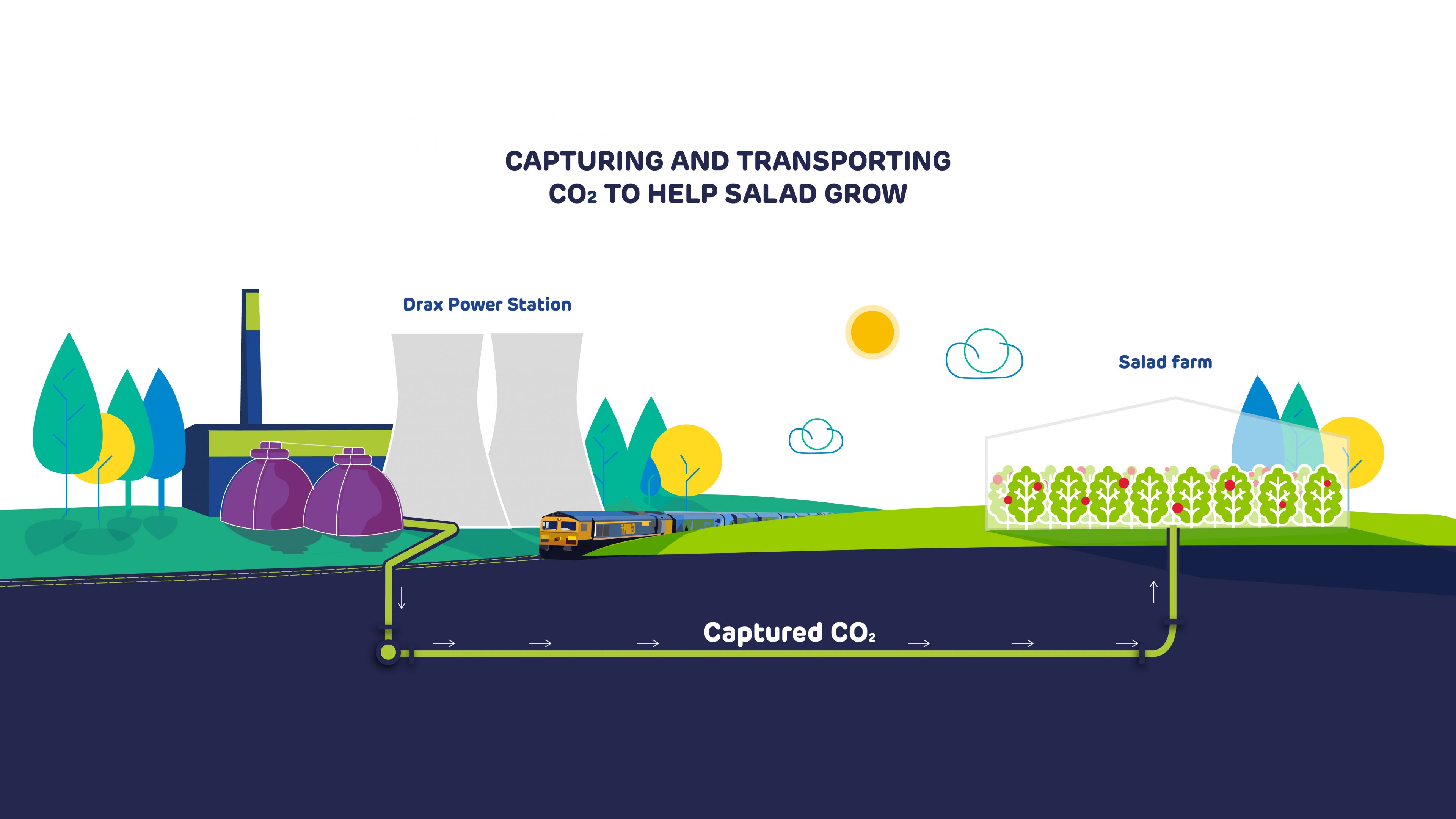
From powering space ships in the 70s to offering greenhouse-gas free transport, fuel cells continue to advance. As low-carbon electricity sources become more important they’re set to play a bigger role yet.

Where does our electricity come from? One answer might be the power stations, wind turbines and solar panels that generate it. You might even go as far as to say the wind, sun, water, biomass and gas powering those stations. Or even the network companies transporting that power around the country. But there’s also a very important middle-man in this process: electricity suppliers.
Most of Great Britain gets its power from one of the ‘Big Six’ energy suppliers, which buy electricity from the wholesale market and then sells it to consumers. However, with more businesses and consumers looking for less carbon-intense electricity sources, there are now a whole host of smaller companies taking on the incumbents and offering all-renewable electricity.
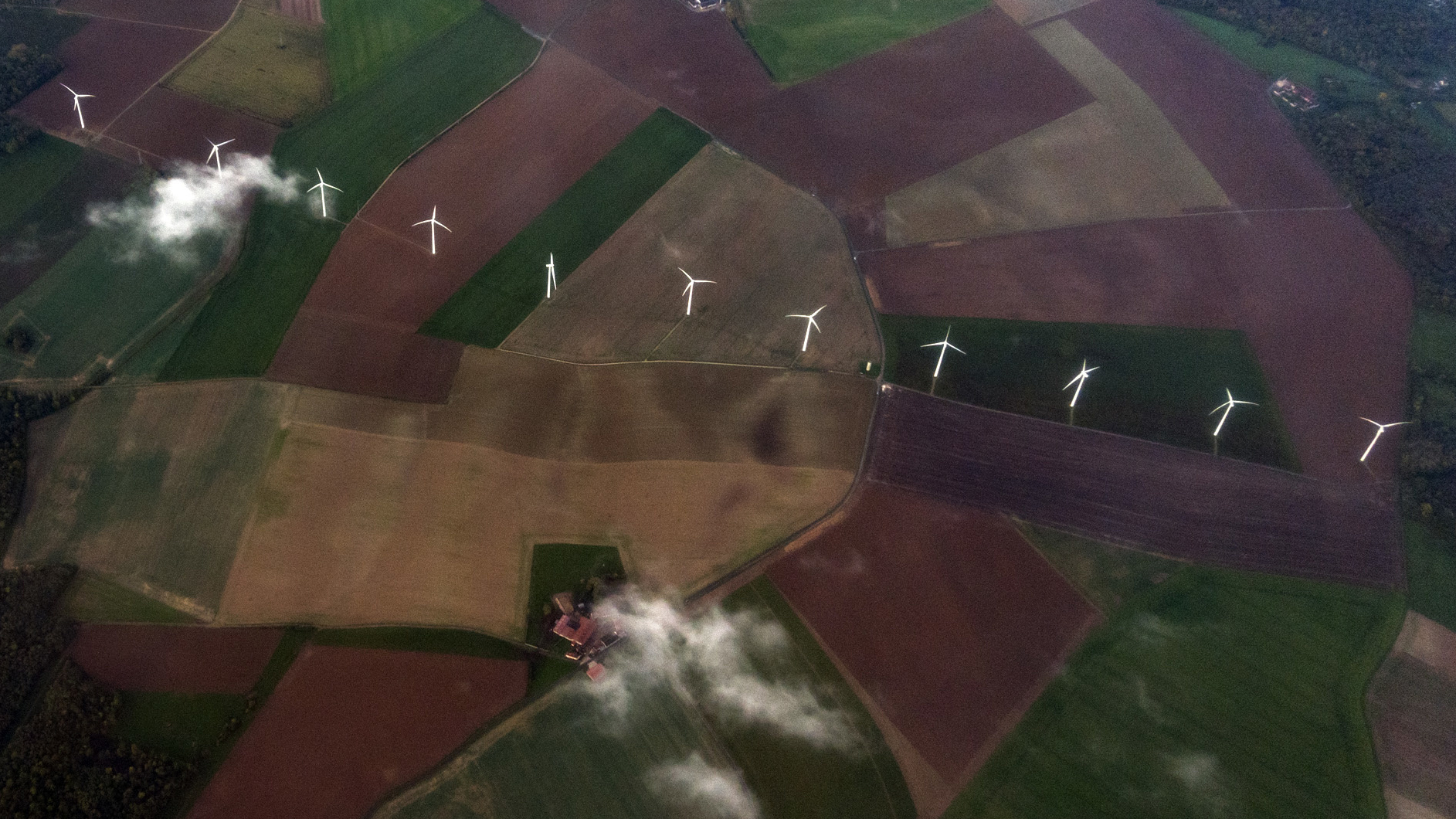
From Ovo to Bulb to Drax’s own Haven Power and Opus Energy, consumers and businesses have more and greener options than ever about where to buy their electricity, with many even offering 100% renewable electricity.
But how do these companies ensure the megawatts powering homes, offices and street lights come from renewable sources?
The electricity we use doesn’t just flow through a single cable from a power station to our houses. It travels through what’s called the transmissions system, which is run by National Grid ESO and local distribution network operators.
Apart from off-grid installations like solar panels on buildings, some of which are unable to export their unused power, all the electricity generated by different sources around the country goes into this same system. It means megawatts generated by a wind turbine get mixed up with those generated by a nuclear reactor or a coal power station.
Think of it as a river. Although it is its own entity, it is fed by multiple streams of water coming from different sources. In the case of electricity, megawatts from various generators are fed into a central system, which then enter homes, offices and devices around the country.
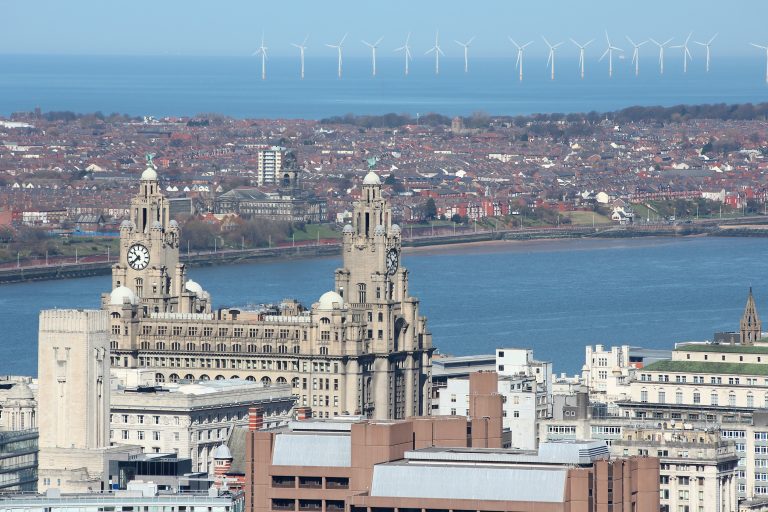
So, what makes green power generated from renewable sources, green power used in homes?
Suppliers can’t control exactly what megawatts you use, but they can influence the makeup of the overall ‘river’ your electricity is pulled from by what electricity they agree to buy and offer to their customers.
Renewable suppliers match the amount of electricity their customers use with the amount they buy from renewable sources. So, if a home uses 4 megawatt-hours (MWh) a year, a supplier will need to ensure it buys an equal amount of power from National Grid, which National Grid sources from generators. If that supplier offers 100% renewable power, it will need to ensure it has the right kinds of deals in place with renewable generators to deliver that amount of power.
It means that while the river of electricity is still a mix from different streams, more of the water will come from renewable streams. Therefore, if more homes and businesses switch to renewable suppliers, more of the overall river will be renewable, which will in turn help to decarbonise the electricity system, enabling a lower-carbon economy.
But how does this fit into the existing electricity business and infrastructure?
But how do suppliers actually buy renewable power from generators?

To understand how suppliers ensure they are buying renewable power you first need to understand how the business works. Or at least, how it used to. The most obvious place to start is with the generators.
Be they gas power stations or an offshore wind farm, the generator is where electricity is produced and are often owned by a supplier.
Suppliers can buy electricity from their own generators, often months or years ahead of delivery. But if there is a shortfall, the supplier can also buy electricity on the wholesale market, where other generators can sell their electricity.
Because suppliers are on a competitive market, their aim is to buy the electricity for the lowest possible price and sell it for more – but at a better rate than rivals. Measures like carbon prices or green incentives help lower the cost of renewable and low-carbon generation, and position it as a more economically viable purchase than more expensive fossil fuels like coal.
Renewable-only suppliers also want to buy electricity as cheap as possible and sell it as affordably as possible. But unlike standard suppliers they only buy electricity from renewable sources.
This can be done by purchasing electricity from independent renewable generators on the wholesale market, or arranged through what are known as Power Purchase Agreements (PPAs) – longer-term contracts between generators and suppliers agreeing on a specific amount of power.
The advantage of these for the renewable generator is it secures revenue for the future, while for the supplier it means a dependable source of electricity. For large installations, these deals are often signed before construction even begins to ensure investors there will be a return.
Transitioning to a low-carbon electricity system, however, is not just about suppliers buying more electricity from renewable sources.

As more businesses, individuals and communities are becoming prosumers and generating their own electricity, the wider role of the supplier in the system is changing.
The government’s feed-in-tariffs financially reward customers for generating their own electricity, even if they don’t export it to the grid. But even small generators can sign deals with suppliers to sell electricity through schemes such as Good Energy’s SmartGen policy, which is open to generators with between 10 and 100 kilowatts (kW) of installed capacity. Similarly Opus Energy helps over 2,100 businesses sell more than 1,100 gigawatt-hours (GWh) of excess wind, solar, anaerobic digestion and hydro power.
For larger prosumer businesses, the relationship with suppliers and the grid is different. Rather than the traditional buying and selling of electricity, it requires a cooperative approach to understand how the prosumer can best utilise their assets.
Beyond increasing the amount of low-carbon electricity, decarbonising the electricity system also means making more efficient use of energy and managing the data that can help improve efficiency. Haven Power’s partnership with Thames Water sees it analyse an average of 68 million half-hour smart meter readings every year, using the data to help the company improve its billing and forecasting. As the wider system becomes more intelligent, suppliers will be able to better forecast how much electricity its customers use and help them reduce their consumption.
The role required of suppliers in a changing system will create opportunities for more renewable and efficient use of electricity. And empower more consumers to get their electricity from low-carbon sources that can help to make the whole country’s electricity greener.
Want a different perspective on the same story? Watch TV’s Jonny Ball explain.